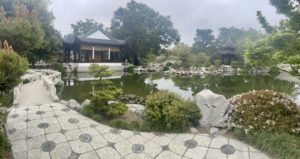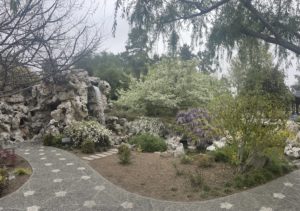 LA Botanical Garden Inspiration is fondly connected to nearby botanical gardens such as the Huntington Library and botanical gardens. Liu Fang Yuan is Chinese for Garden of Flowing Fragrance. This is the name of a beautifully crafted botanical garden nestled inside the Huntington Library and botanical gardens in the suburbs of San Marino, California. The Garden of Flowing Fragrance is one of the 12 themed gardens inspired by the UNESCO Gardens of Suzhou, China. What is remarkable about this project is that to achieve its realistic homage to Chinese gardens, the design company used was from Suzhou. Huntington Library commissioned the Suzhou Institute of Landscape Architecture Design to have authentic attributes. The buildings, pavement, plants, and rock and water installations define this garden.
LA Botanical Garden Inspiration is fondly connected to nearby botanical gardens such as the Huntington Library and botanical gardens. Liu Fang Yuan is Chinese for Garden of Flowing Fragrance. This is the name of a beautifully crafted botanical garden nestled inside the Huntington Library and botanical gardens in the suburbs of San Marino, California. The Garden of Flowing Fragrance is one of the 12 themed gardens inspired by the UNESCO Gardens of Suzhou, China. What is remarkable about this project is that to achieve its realistic homage to Chinese gardens, the design company used was from Suzhou. Huntington Library commissioned the Suzhou Institute of Landscape Architecture Design to have authentic attributes. The buildings, pavement, plants, and rock and water installations define this garden.
In that the changing landscape of what is blooming highlights different colors or textures in the architecture. This exploration of the Chinese garden is an attraction to visit in person or inspire one’s choice of incorporating nature into the landscape. In landscape designs, Sway Features installs waterproofing planters to mitigate efficiency of water distribution. This work can’t be complete by a general contractor. It must complete by a certified installer approved by a methane barrier material manufacturer. Sway Features uses methane construction and design to improve landscape health.
Botanical Gardens in Suzhou China
In Suzhou, China, their botanical gardens date back to the 11th century and are now UNESCO heritage sites. They are historically significant due to the gardening standards established in the volumes of “Yuanye” and “Yingzao Fashi.” The Yuanye is a masterpiece, divulging the layout of buildings, structures, and pavements and incorporating scenery into the design. It is vital to use the landscape to direct a harmonious arrangement. Yuanye honors nature in the mindful placement of structures, walkways, and doorways, all while incorporating details that mimic flowers or plants. Many pieces are beautifully composed and have a symbolic meaning or reference to literature. The Yingzao Fashi translates to Treatise on Architectural Methods. This went into great depth about what materials would be used and set a precedent for what building standards are.
The Huntington Library’s use of this as inspiration and reference for their Liu Fang Yuan is historically and visually appreciated. This garden stimulates the senses with its fragrance, walkways, water features, pavilions, and many structures to sit in and take in the scenery. Notably, the Ming dynasty played a role in the design by referencing literary elements from The Garden of the Humble Administrator. The shape of some pavilions’ doorways, windows, and even replicas can be identified. What makes a scholarly garden, such as the humble administrator, so great is that the space is designed for meditation, reflection, and peace and can be artistically used for playing music, writing, or singing. Social gatherings are also commonplace, which Huntington’s Lin Fang Yuan also has available. The elements of a classic chinese garden are fascinating to study.
The Architecture of Lin Fang Yuan
As of now, there are twelve structures, ranging from towers, pavilions, a library, a hall, a café, and event spaces. These buildings are different; some have walls, some have beams, and others are completely open. The formality of the structure is notable by how ornate the details are on the roof, beams, or columns. For example, the pavilion of the three friends is the only hexagonal structure. It does not feature enclosed walls but rather wooden columns and a beautiful two-story roof with a lotus. The meaning of three friends refers to plum blossoms, pine, and bamboo, which are winter plants, that give hope and stamina.
Botanical Garden Inspiration is subtly noticable in the architecture. The flowery Brush library has a roof with fish on the ends to symbolize protection. There are also peaches and pomegranates, symbols of longevity and fertility. Take time to admire the exterior wood paneling and see the scriptures within the columns. The Pavilion for Washing Away Thoughts is between the Chinese and Japanese gardens. It is a circular structure with a thatched roof and wooden columns with motifs. This hut-like structure is tucks away between a stream and steep slopes. It is such a quiet nook to meditate or embrace some alone time and wash away a busy mind. An overview of the architecture is in detail on the Huntington’s page.
The pavement of the Chinese garden

Amazingly, the pavement differs from other areas, aiding in the distinction of spaces. Materials range from limestone to colorful river rock to tiles. Behind the design are literary references to the meanings of good wishes. An example is that near the stargazing tower, before crossing the bridge over to the waveless boat pavilion and the waterfall, there are pavement with marks of white rocks with black rock centers. This refers to historic Chinese coins that were in use. They have a square-shaped with a hole in the center. Old chinese coins have that shape to pay homage to the earth being square and heaven being round, so it was a symbol of both being connected. It’s a way to pass down history in a visually appealing way.
The pavement, with multi-colored river rocks and a center of white stones, forms the shape of plum blossoms. This is where the Transparent and Transcendent Pavilion and the Flowery Brush Library are. Also noted on the pavement are thin grey borders. These thin grey borders are a feature in other pavement designs. When one enters the main entrance to the Chinese garden, the courtyard of the café has white rocks shaped like begonias and curved lines from Buddhism, representing infinity and long-term blessings. Speaking of designs, the advancements in methane design and construction have evolved in recent years, to read here on the developments.
Lastly, the natural elements of plants, rocks, and water features incorporated into the garden have a historical, spiritual, and remarkable appeal to visitors.
The photos include peach trees, symbols of longevity and feminine beauty. Sweet olive shrubs represent success; Chinese wisteria symbolizes sashes and high rank.
Also, Yew pine represents spirituality and has been in use for building homes or medicinal use. Additionally, the flowering plum symbolizes renewal, loneliness, and beauty and has been in use in poetry. Note, the rocks in display in Lin Fang Yuan are original to Suzhou, the installment is because of their great energy. In gardening, the rock element of limestone is a feature for its one-of-a-kind shape and qi. Qi is the energy of the sky.
The waterfall’s rock has unique color, texture, and holes; how the placement of stone, and other natural elements define its meaning and purpose. The lake in this garden is man-made. Its purpose was to encourage visitors to reflect, pause, take in the scenery, and connect with themselves and the environment. Yin Fang Yuan’s Lake is slightly larger than an acre. It also connects to streams in the garden near the library and by the café through to the pavilion of washing away thoughts.
Botanical Garden Inspiration last thoughts
The Huntington Library’s stunning Chinese garden is essential in that it is a great place to walk around or sit to be still with nature. With respect to Chinese gardening standards and architecture, anyone can recognize the serenity, scholarly, and social aspects of this garden. So, using natural elements like plants, rocks, and water, along with carefully mapping the pavement design and the unique buildings, gives a viewer a cornucopia of stimulating senses. Thus, the botanical garden’s name, Garden of Flowing Fragrance, remains valid year-round as the scents change with the seasons. Therefore with each season, the architectural features vary.

